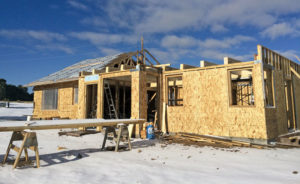By Sue Snively
I stare in wonder at the local post office parking lot as I leash my little papillon dog to pick up my mail. The parking lot is full of SUVs and pickups, most with a dog inside waiting patiently for his “significant other” to emerge from those hallowed halls and drive him home a mile or two away.
Later in the day, this wonderment continues as I survey the grocery store parking lot full of the same vehicles. Further observation shows most of the owners of the vehicles emerging from the store with only one or two bags of groceries; a few, however, are there to get a weeks worth of food, which certainly justifies transporting by motor vehicle.
In the age when scientists put climate change front and center in terms of a looming global crisis, it seems many of us sit back and expect the government to take steps to solve the crisis before the problems created by climate change become insurmountable.
[InContentAdTwo]
On the subject of transportation, the biggest driver of greenhouse gasses (GHG), great strides have occurred in the last 20 years to contain GHG emissions from all vehicles. Technology has done a remarkable job, but at the same time there are more people on the roads. Unfortunately, as alluded to above, a lot of those vehicle trips are short-distance driving, which, in spite of cleaner engines, still puts a considerable amount of GHG into the air. A recent article in a Sierra Club magazine indicated that “short trip” driving creates more GHG than all the trucks moving our goods down the highways. Perhaps rules and regulations need to be put in place that prohibit able-bodied humans from driving when the intended trips are less than two miles long. The use of bicycles and/or walking power would not only curtail emission of GHG, but would create a much healthier populace.
We look to the federal government to pass nationwide laws to save us from looming disaster. Because of partisanship in the United States fueled by those congressmen who believe strongly that man is a major driver of climate change and those legislators who deny the existence of human influence on our rapidly warming earth, federal legislation is dicey business. Under the current president and congress, such positive legislation is on hold.
What is happening from a government standpoint is widespread legislation by state and local governments to mitigate the problem. Colorado has passed extensive legislation mandating utilities to gradually convert their power sources from fossil fuels to renewables such as solar, wind and hydrothermal. The state has set mandates allowing for a gradual conversion leading to a certain reduction by 2030.
Local conversion, due to those mandates has prompted Sangre de Cristo Electric to propose installing a large solar panel conglomerate on the grounds of the correctional facility in Buena Vista. The facility will be financed in part by allowing businesses and residents to purchase their own solar panel or panels. The power produced by the individual panels will be sold back to the electric company in terms of bill credits on the residents or businesses who own the panels. The same scenario is true for those who purchase wind turbines.
One only has to look to the progressive laws passed by California to see how that very populated state is dealing with the greenhouse gas problem.
As early as 2006, California passed Assembly Bill 32 requiring the state to reduce GHG emissions to 1990 levels by 2020. That would be approximately a 15 percent reduction below the “business as usual” scenario. Seven GHG’s and other gases were to be included in the reduction. They include carbon dioxide, methane, nitrous oxide, hydrofluorocarbons, perfluorocarbons, sulfur hexafluoride, and nitrogen trifluoride.
The efforts for reducing greenhouse gases through AB 32 has been ongoing in California, and is being accomplished by implementing a combination of approaches including local planning, direct state regulations, market policies, and promotional incentives. Those efforts target emission reductions from all forms of transportation, electricity and natural gas production and use, and other sources.
In the trend to let government take the lead, there is a tendency of the populace to be complacent on the issue to the point of not being diligent about following the government rules and regulations, especially if doing so affects the financial interest of individuals, businesses and/or corporations.
On the individual side, common sense practices can have a major influence over the amount of GHG put into the air. Certainly our in-home energy practices are a measure of the amount of the daily GHG output. One only has to walk the residential streets at night to see examples of overuse of electricity. Rather than have lights only where needed, whole houses are lit up; those same houses characteristically have temperature regulation systems controlled by thermostats. That is good, but only if the homeowners who set those thermostats use settings conducive to cutting back on energy use, whether that energy is derived from fossil fuels or renewables.
Local residents can choose to regulate a large domestic power consumer, the electric or gas clothes dryer, by installing clotheslines. In states like ours with dry climates, air drying on most days is a viable option. Even during inclement weather, inside air drying is a possibility. It just takes longer.
Water heaters are another household culprit. Thermostat settings can be set lower for household tasks such as washing clothes and dishes. Timely showering and bathing can be done with lower water temperatures.
The components mentioned above are only a few of the many aspects of containment of GHG that individuals can undertake. Every one of us has a personal responsibility to ourselves, each other, and future generations to do what we can to contain these harmful gases for a healthier planet. ?
Sue Snively is a bit of reactionary in both her writing and her thinking.



